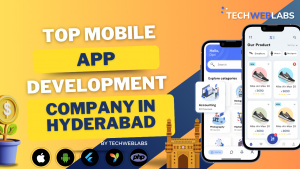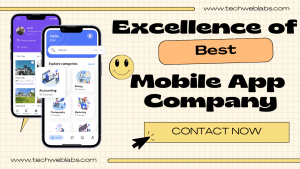Fitness App Development: Your Guide to Building an Engaging and Effective Fitness App
Introduction
In the modern world, where health and fitness have become a priority for many, fitness apps have emerged as popular tools for users to track their progress, set goals, and stay motivated. Developing a fitness app that stands out in the competitive market requires careful planning and execution. In this article, we will dive into the step-by-step process of creating a fitness app, discuss creative ideas to enhance user engagement, explore essential features that users expect, answer frequently asked questions, and highlight the role of Techweblabs in app development.

Fitness App Development: Steps, Ideas, and Features
1. Understanding the Target Audience
To create a successful fitness app, it is crucial to understand the target audience. Different users have different fitness goals and preferences. Conduct thorough research to identify the needs and pain points of your potential users. Consider factors such as user demographics, fitness goals, and user preferences to create a user-centric app.
2. Market Research and Competitor Analysis
Before you start developing your fitness app, conduct comprehensive market research to understand the current trends and demands in the fitness app market. Additionally, analyze your competitors’ apps to identify gaps and opportunities for improvement. Utilize fitness app market analysis and competitor features to gain insights for your app’s development.
3. Defining App Objectives and Unique Selling Points (USPs)
Clearly define the objectives of your fitness app and outline its unique selling points. What sets your app apart from others in the market? Focus on the aspects that will make your app stand out and appeal to your target audience. Highlight your fitness app USPs and differentiation to attract users effectively.
4. Designing the User Interface (UI) and User Experience (UX)
An intuitive and visually appealing user interface is crucial for any fitness app’s success. Collaborate with experienced UI/UX designers to create a user-friendly app that offers a seamless experience. Ensure your fitness app design meets the highest standards of UI/UX and user-friendly interface.
5. Choosing the Right Technology Stack
Selecting the appropriate technology stack is vital to ensure the app’s smooth performance and scalability. Consider factors such as app platform (iOS, Android, or both), programming languages, and frameworks. Opt for a technology stack that aligns with your fitness app’s requirements and future scalability. Some recommended tech stacks include:
- For iOS: Swift with Xcode
- For Android: Kotlin with Android Studio
- Cross-platform: React Native or Flutter
6. Building a Minimum Viable Product (MVP)
Start by developing a Minimum Viable Product (MVP) with essential features to test your app’s concept and gather feedback from early users. This approach allows you to make improvements based on real-world usage. Utilize MVP testing and user feedback to refine your fitness app.
7. Integration of Wearable Devices and Fitness Trackers
To enhance the user experience and provide accurate fitness data, consider integrating your app with popular wearable devices and fitness trackers. Emphasize data integration with wearable devices and fitness trackers to offer a comprehensive fitness tracking experience.
8. Gamification and Rewards System
Implement gamification elements, such as badges, challenges, and rewards, to keep users engaged and motivated to achieve their fitness goals. Gamify the fitness app experience with challenges and rewards to enhance user engagement.
9. Personalization and Customization
Offer personalized workout plans and nutrition suggestions based on individual user preferences, fitness levels, and goals. Customization enhances user engagement and makes the app more valuable to users. Provide personalized fitness plans and customized nutrition options to meet user needs.
10. Social Sharing and Community Building
Incorporate social sharing features to allow users to share their achievements and progress with friends and build a supportive fitness community within the app. Enable social sharing and fitness community features for a collaborative and motivational fitness journey.
11. Real-time Progress Tracking and Analytics
Enable real-time tracking of fitness progress and provide users with detailed analytics and insights into their workouts, calories burned, and overall progress. Empower users with real-time progress tracking and valuable workout analytics.
12. Push Notifications and Reminders
Implement push notifications and reminders to keep users informed about their workout schedules, upcoming challenges, and motivational messages. Use push notifications to remind users of their workout commitments and provide motivational messages.
13. In-app Purchases and Subscription Models
Monetize your fitness app by offering in-app purchases for premium features or subscription models with additional benefits for subscribers. Integrate in-app purchases and subscription models for revenue generation.
14. Beta Testing and Quality Assurance
Before the official launch, conduct thorough beta testing to identify and fix any bugs or issues. Quality assurance is crucial to ensure a smooth user experience. Prioritize beta testing and quality assurance to deliver a bug-free app.
15. App Store Optimization (ASO)
To increase app visibility and downloads, optimize your app’s listing on app stores with relevant keywords, captivating descriptions, and attractive app icons. Utilize app store optimization techniques for better visibility.
16. Launching the Fitness App
Coordinate a well-planned launch strategy to create buzz around your fitness app. Utilize social media, influencers, and marketing campaigns to reach your target audience effectively. Plan a successful app launch using social media and influencer marketing.
17. Collecting User Feedback and Iterative Improvements
After the launch, gather user feedback and reviews to make iterative improvements and enhance the app’s overall performance. Continuously improve the app based on user feedback for better user satisfaction.
18. Data Security and Privacy Compliance
Ensure that your fitness app complies with data security and privacy regulations to build trust among users. Implement robust security measures to protect user data and privacy.
19. Collaborations and Partnerships
Consider forming partnerships with fitness experts, trainers, or nutritionists to offer exclusive content and value-added services within the app. Collaborate with fitness experts for valuable fitness content and services.
20. User Retention and Engagement Strategies
Develop strategies to retain users and keep them engaged with the app over the long term. Frequent updates, new features, and exciting challenges can help maintain user interest. Implement user retention and engagement strategies for long-term app success.
21. Handling Customer Support and Queries
Establish a reliable customer support system to address user queries, concerns, and technical issues promptly. Excellent customer service fosters positive user experiences. Prioritize customer support and prompt query resolution for positive user experiences.
22. Scaling and Future Enhancements
Plan for scalability and future enhancements as your fitness app gains popularity and user base. Stay updated with technology advancements and evolving user needs. Plan for future app scaling and technology updates.
23. Implementing User Feedback and Feature Requests
Actively listen to user feedback and consider implementing popular feature requests. User-centric improvements can lead to increased user satisfaction and app success. Implement user feedback and prioritize popular feature requests.
FAQs
Q: How long does it take to develop a fitness app?
A: The development time for a fitness app can vary depending on its complexity and features. On average, it may take several months to develop a fully functional fitness app.
Q: Can I integrate third-party fitness APIs into my app?
A: Yes, integrating third-party fitness APIs can enhance your app’s functionality by accessing features such as workout data, nutrition information, and activity tracking.
Q: What are some essential features for a fitness app?
A: Some essential features include workout tracking, exercise demonstrations, nutrition tracking, social sharing, and personalized workout plans.
Q: How can I monetize my fitness app?
A: You can monetize your app through in-app purchases for premium features, subscription models, or even through partnerships and collaborations with fitness experts.
Q: Is app maintenance necessary after the launch?
A: Yes, app maintenance is crucial to fix bugs, provide updates, and ensure smooth functionality to retain users and enhance the app’s performance.
Q: Can I target a specific niche within the fitness app market?
A: Absolutely! Targeting a specific niche, such as yoga enthusiasts or runners, can help you tailor your app’s features to meet their unique needs and preferences.
Techweblabs: Your Mobile App Development Partner
When it comes to building innovative and user-centric fitness apps, Techweblabs is a top mobile app development company that stands out in the industry. With a team of skilled developers, UI/UX experts, and app strategists, Techweblabs delivers cutting-edge fitness app solutions. They understand the importance of a seamless user experience and incorporate the latest technologies to create engaging and performance-driven fitness apps. Whether you need an iOS, Android, or cross-platform app, Techweblabs has the expertise to turn your fitness app idea into reality.
In conclusion, developing a successful fitness app requires a combination of innovative ideas, user-centric features, and seamless execution. By following the outlined steps, incorporating creative ideas, and considering Techweblabs as your development partner, you can create a fitness app that resonates with your target audience, keeps users engaged, and helps them achieve their fitness goals effectively.


